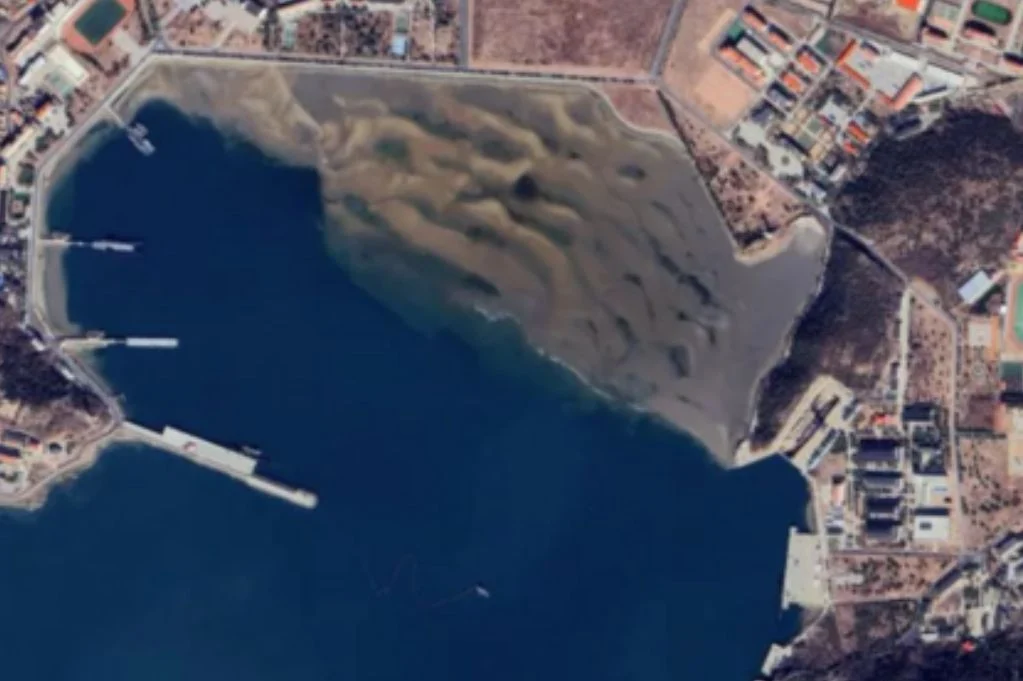
Satellite Imagery Reveals Expansion of China’s Nuclear Submarine Fleet Near Taiwan: Report
Newly surfaced satellite images accessed through Google Maps have revealed striking visuals of China’s expanding nuclear-powered submarine fleet, according to a report by The U.S. Sun. The images, shared by an Australian naval analyst, show at least six nuclear submarines docked at the country’s major naval hub near Qingdao, underscoring Beijing’s growing maritime capabilities and strategic ambitions amid rising tensions in the Indo-Pacific, particularly around Taiwan.
Strategic Submarine Presence at Qingdao’s First Submarine Base
The submarine base in question—referred to as the First Submarine Base—is located approximately 18 kilometers east of Qingdao, a major port city along the Yellow Sea. This base has long been a critical node in China’s naval infrastructure. Its geographic location provides swift access to the East China Sea, South Korea, Japan, and the Taiwan Strait, placing it within striking distance of key flashpoints in the region.
According to the report, satellite images show a total of six submarines docked at the base, five of which are nuclear-powered attack submarines believed to be armed with conventional weapons. The analysis and images were shared by Australian naval analyst Alex Luck on the social media platform X (formerly Twitter).
Luck identified the vessels as:
Two Type 091 submarines (China’s first generation of nuclear attack submarines)
Two Type 093A submarines (more advanced and quieter than their predecessors)
One unidentified submarine, believed to be undergoing maintenance or decommissioning
One Type 092 ballistic missile submarine, notable as China’s first nuclear-powered submarine capable of launching ballistic missiles
Luck suggested that the unidentified submarine may be in the process of being scrapped, given the visible signs of disassembly or repairs at a nearby dockyard facility. The satellite imagery appears to capture work being carried out, possibly indicating aging infrastructure or rotation of older vessels out of service.
Visible Signs of Naval Modernization
The presence of the Type 093A submarines—part of China’s newer class of attack submarines—highlights the People’s Liberation Army Navy’s (PLAN) ongoing effort to replace older models like the Type 091 with quieter, more advanced, and longer-range platforms. The Type 093A is reportedly more stealth-capable, designed to challenge U.S. and allied naval dominance in the Pacific.
Although the Type 092 submarine is still visible in the imagery, it has largely been replaced in China’s active sea-based deterrent role by the newer and more capable Type 094 ballistic missile submarines. These submarines form a key pillar of China’s nuclear triad, capable of launching JL-2 or JL-3 nuclear missiles, significantly enhancing the country’s second-strike capability.
The new images bolster earlier reports suggesting that China is heavily investing in both nuclear-powered and conventional submarines, a strategy that aligns with the country’s broader maritime doctrine and ambitions to become a dominant naval power by mid-century.
Unconfirmed Reports of a Submarine Incident
The Sun report also references unconfirmed rumors from mid-2023 that one of China’s newer submarines, possibly a Type 041 nuclear-powered attack submarine, sank during dockyard maintenance in May or June. These reports, while circulating in defense and maritime communities, have not been verified by independent sources or Chinese authorities.
It’s worth noting that the Type 041 designation typically refers to the Yuan-class submarine, which is diesel-electric, not nuclear-powered. This discrepancy highlights ongoing confusion and secrecy surrounding Chinese naval classifications and developments. Some defense analysts speculate that newer nuclear-powered variants may be under development and not yet fully disclosed to the public.
China’s Strategic Focus on Submarine Warfare
The report cited Chinese Navy Captain Wen Xuexing, who in June 2023 stated, “Now, the country’s submarine force development comprises both nuclear-powered and conventional boats, with nuclear-powered being the main focus.”
This aligns with broader geopolitical assessments that China is prioritizing nuclear-powered submarines to support its long-range maritime ambitions. Nuclear-powered submarines offer greater endurance, allowing vessels to remain submerged for extended periods, cover larger distances without surfacing, and deploy in more strategic locations for longer durations.
With rising regional tensions—especially over Taiwan, the South China Sea, and US-China naval standoffs—Beijing’s emphasis on submarine warfare suggests a calculated move to enhance both deterrence and power projection in contested waters.
Implications for Regional Security and Taiwan
The expansion of China’s submarine fleet, particularly the stationing of multiple nuclear-powered vessels at its northern naval bases, raises concerns among Taiwanese defense planners, U.S. military officials, and allies such as Japan, South Korea, and Australia. While the Qingdao base is situated farther from Taiwan than China’s southern submarine facilities like Yulin Naval Base in Hainan, the presence of nuclear submarines there adds depth and flexibility to Beijing’s strategic capabilities.
As satellite surveillance technologies improve, open-source intelligence (OSINT) analysts have become increasingly successful at tracking military deployments in real time. The availability of such high-resolution satellite imagery on public platforms like Google Maps has become a double-edged sword—exposing military secrets, but also reinforcing transparency in a time of growing suspicion between global powers.
While HT.com was unable to independently verify the authenticity of the Sun report or the imagery posted by Alex Luck, the pattern of activity aligns with what experts have described as China’s quiet but determined naval buildup.
Conclusion: A Subtle Yet Strategic Signal
The latest satellite revelations serve as a stark reminder of the intensifying naval arms race in the Indo-Pacific. With the U.S. and its allies increasing their naval presence in response to Beijing’s assertiveness, the appearance of six nuclear submarines at a single Chinese base signals not only enhanced operational readiness but also a strategic posture shift.
Whether intended or coincidental, the timing of the imagery release—amid renewed U.S.-China tensions over Taiwan, South China Sea passages, and military drills—underscores the urgency with which regional powers are recalibrating their maritime strategies.
As the world’s two largest economies continue to navigate complex diplomatic waters, the underwater domain may well become the most critical—and opaque—frontline in shaping the future of global security.



















